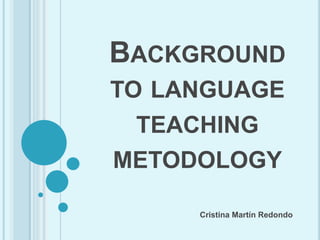
Background to language teaching metodology
- 2. HOW PEOPLE LEARN LANGUAGES ACQUISITION & LEARNING COMPREHENSIBLE INPUT: Exposed to language above their own level. INPUT HYPOTHESIS, Stephen Krashen EXPOSURE Subconscious process More than one language in childhool Age Important factor We do it CONSCIOUSLY Grammar – functions - vocabulary The language we learn consciously is different from de language we acquire through comprehensible input Learnt language could not become acquired anguage.
- 3. PROBLEMS Not have the opportunity to live in a foreign country. Children are not ready to learn language (STUDY) because their age. Effort to acquire a new language. Activities of language-learning lessons: focused on acquisition/on learning.
- 4. 4 METHODS TO LEARN LANGUAGES GRAMMAR- TRANSLATION AUDIO-LINGUAL METHODOLOGY TASK-BASED LEARNING (TBL) THE COMMUNICATIVE APPROACH/ COMMUNICATIVE LANGUAGE TEACHING (CLT) Target language own language - People get language if they have opportunities to use it. - Focuses on CONTENT. Speaking practice by using habit-formation DRILLS. •Theory of BEHAVIOURISM Stimulus-response-reinforcemente Language study comes after the task. SYLLABUS
- 5. STUDENTS MAKE MISTAKES Why? DEVELOPMENTAL ERRORS (try to work out how language system work) OVER-GENERALISATION (use the new rule too widely) INTERFERENCE (use the first language knowledge) INTERLANGUAGE FOSSILISED (mistakes are left uncorrected for too long)
- 6. KINDS OF MISTAKES SLIP Result of tiredness/speak quickly and careless. ERRORS Learn something incorrectly. Developmental or interference factors. ATTEMPS To say things beyond their language. CORRECT IT APPROPRIATELY
- 7. TEACHERS SHOULD SCAFFOLD STUDENT’S LEARNING LEARNING AT DIFFERENT AGES Children are better language learners than other age groups. VYGOTSKY Children learn best when they are in the ZONE OF PROXIMAL DEVELOPMENT. Adolescents need PEER APPROVAL The good opinion of their classmates
- 8. Tips for teaching teenagers: - Encourage teenagers to have opinions and to think critically and questioningly about what they are learning - Use the students’ own knowledge and experience as much as posible - Treat the students like adults but remember they are still children - Encourage the students to have agency - Be organised - Be consistent whe they are discipline problems
- 9. STUDEN-CENTRED TEACHING PERSONALISATION: think about the right language to use to express their own ideasand talk. AGENCY: learners have some responsability for their own learning. LEARNER TRAINING: get students to think of the best ways of doing things. Some adults… Are not keen on COMMUNICATIVE LANGUAGE TEACHING, want to translateevery word into their own language and have some problems with memory (necesary to RECYCLE and REVISE). Some teenagers… Need to understand the LESSON OUTCOMES we expect for them, have unresolved problems with SELF-ESTEEM, are far more likely to enjoy lessons and want to know that their teacher is interested in their progress.
- 10. LEARNER CHARACTERISTICS Try to guess when they don’t know something Try to get their message across even if their knowledge of the language isn’t very good Are prepared to make mistakes Try to figure out how language works Practise whenever they can Analyse the way they and others talk Have a good self-image and confidence THEGOODLEARNER
- 11. APTITUDE depends on MOTIVATION Theory of MULTIPLE INTELLIGENCES Everyone has the same intelligences, but we are all differents. EMOTIONAL INTELLIGENCE Ability to understand and deal with our own emotions and the emotions of others Students are categorized according to the LEARNING STYLES. Neuro-linguistic programming has been used to explain learners differences: Different lessons for different kinds of student preferences Try to encourage LEARNER AUTONOMY by offering LEARNER TRAINING
- 12. DIFFERENT CONTEXTS, DIFFERENT LEVELS We can do a NEEDS ANALYSIS to find out what future contexts learners will need to use English in. DIFFERENT KINDS OF ENGLISH LEARNING GENERAL ENGLISH Learning the language for no special reason ENGLISH FOR SPECIFIC PURPOSE (ESP) BUSINESS ENGLISH ENGLISH FOR ACADEMIC PURPOSE (EAP) ONE-TO-ONE CLASSES (one student, one teacher) CONTENT AND LANGUAGE INTEGRATED LEARNING (CLIL) Specially at primary and secondary Marries the learning of new language to the learning of school- curriculum subjects
- 13. DIFFERENT STUDENTS LEVEL advanced upper-intermediate intermediate lower-intermediate/pre-intermediate elementary real beginner false begginer begginers elementary intermediate advancedv false begginers pre-intermediate upper-intermediate A1 A2 B1 B2 C1 C2
- 14. LARGE AND MIXED-ABILITY CLASSES In large classes is IMPORTANT: o Be very organised o Give very clear instructions o Make it clear when we are moving for one stage of a lesson o Establish clear routines o Maximise the use of pairwork and groupwork o Use choral repetition
- 15. MOTIVATION ⋆ EXTRINSIC MOTIVATION: comes from outside the learner. ⋆ INTRINSIC MOTIVATION: comes from the task it self. ⋆ INTEGRATIVE MOTIVATION: language learner wish to integrate into the target language culture. ⋆ INSTRUMENTAL MOTIVATION: language learner is studying because some materialistic reason. The students’ motivation may be affected by a number of factors (society, people around them, their learning experiences…).